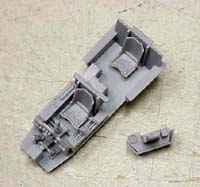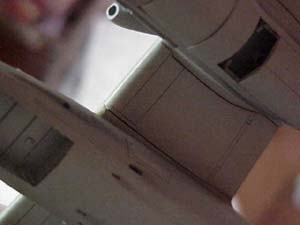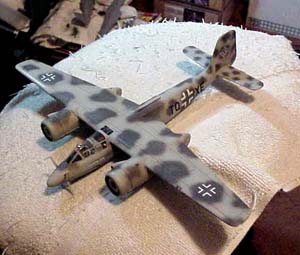


 Revell-Monogram
1/48 Ta154 Moskito
Revell-Monogram
1/48 Ta154 Moskito
By Larry Horyna
History
One of the Luftwaffe's more unusual aircraft in terms of it's service life was undoubtedly the Focke-Wulf Ta154 'Moskito'. Records exist that would support that over 150 examples of this designated night fighter were built. However, the Ta154 was never "produced" as a real production aircraft! The 150 or so airframes were all essentially prototypes with no more than 10 or so examples of each variant built. The aircraft's real setback was the German's lack of any suitable adhesive for their version of the "wooden wonder". In fact, it was the British who developed epoxy resins in the development of the De Havilland Mosquito. The German's were using phenolic resins, ie Elmer's type glue! This didn't hold up too well, especially in wet conditions! Now fans of WWII German night fighters can rejoice as this unusual airplane is now available in a medium other than vacu-form. This kit was originally a DML mould and was picked up by Revellogram and put into their pro modeller series.
 The
kit is moulded in light gray plastic with markings for two aircraft. I
personally do not care for the "soft" plastic that Revell-Monogram has
used on this kit. Just the slightest extra amount of pressure and a new
x-acto blade will go through like a hot knife through butter. The cockpit
is sufficient in detail although an aftermarket set would certainly enhance
things in this area. The fuselage fit with no problems as did the horizontal
stabs. Then I hit the wings.
The
kit is moulded in light gray plastic with markings for two aircraft. I
personally do not care for the "soft" plastic that Revell-Monogram has
used on this kit. Just the slightest extra amount of pressure and a new
x-acto blade will go through like a hot knife through butter. The cockpit
is sufficient in detail although an aftermarket set would certainly enhance
things in this area. The fuselage fit with no problems as did the horizontal
stabs. Then I hit the wings.
The Ta154 was somewhat unusual in that it had zero dihedral and this coupled with the forward swept trailing edges give the wings a somewhat "drooped" look. However, the wings in my kit were definitely drooped due to the warpage! This was not as easy to fix as one might think. Once the dihedral was corrected, the fit of the wings to the fuselage was the next bear to tackle. The fit wasn't horrible, but a bit of filler was needed, especially under the wing root. Quite a bit of weight will be needed to get the airplane to sit on its tricycle gear and there isn't any room in the nose to speak of for this. Luckily, the engine nacelles protrude out in front of the center of gravity far enough and have enough room in them to allow enough weight for balance.
 Now
some may think this a petty gripe, but I hate kits that are engineered
to put in the landing gear as part of the main assembly. The nose gear
is designed to be glued into place as part of the fuselage assembly. I
didn't do this on purpose and just shaved off the sides of the nose gear
pinning joint later on. The main gear were very well designed and fit
quite well. Most of the assembly was straightforward and the instructions
posed no confusing problems.
Now
some may think this a petty gripe, but I hate kits that are engineered
to put in the landing gear as part of the main assembly. The nose gear
is designed to be glued into place as part of the fuselage assembly. I
didn't do this on purpose and just shaved off the sides of the nose gear
pinning joint later on. The main gear were very well designed and fit
quite well. Most of the assembly was straightforward and the instructions
posed no confusing problems.
Perhaps the most difficult aspect of building was cutting out the radar horns from the sprues. The sprue attachment points were quite thick (I'm sure a necessity to assure as fine molding) and this made it a very delicate operation! If I were building this for a competition I would probably opt to scratch build the radar, but for injection molding, the kit supplied radar horns are fine. The way in which the radar is tooled made for easy assembly with no problems in alignment. The canopy fit well, was nice and clear, but had some hairline flaws. These can probably be polished out but for this review I didn't bother. Probably my biggest problem with this kit was the decals. I usually avoid any body's kit decals and this reminded me why. I had a lot of silvering using the same techniques I always use with Aeromaster or Superscale decals and never have problems.
 All
in all, this builds up into an attractive model. It really needs about
twice the amount of time I spent (roughly 15 to 20 hours, I don't keep
that close a tab on my building time) to make it look really good. The
bottom line to me concerning fit is its relation to cost. For a twin engined
1/48 model, this kit is priced well at about 30.00 (you can usually find
it for about 25.00 on average) making some of the fit and warpage problems
tolerable. However, this is definitely not Hasegawa or Tamiya kit!
All
in all, this builds up into an attractive model. It really needs about
twice the amount of time I spent (roughly 15 to 20 hours, I don't keep
that close a tab on my building time) to make it look really good. The
bottom line to me concerning fit is its relation to cost. For a twin engined
1/48 model, this kit is priced well at about 30.00 (you can usually find
it for about 25.00 on average) making some of the fit and warpage problems
tolerable. However, this is definitely not Hasegawa or Tamiya kit!
Our thanks to Revell-Monogram for this review sample!

Previous: Contents








